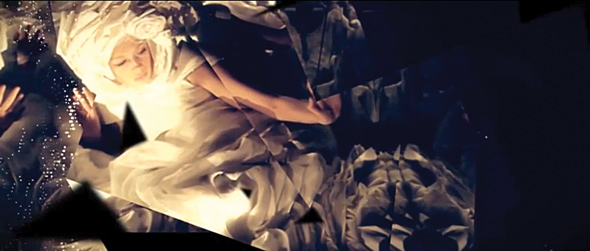
A low electronic growl.
A flicker of light across a black screen.
A nude female figure, stark white, writhes in restraints, fading in and out of the darkness.
The soundtrack sizzles and pulses, and the images grow choppier. Lightning strikes. Patterns fly across contorted struggling bodies—electric stripes, stark cross-hatching. Luminous purple cloth flutters in slow motion as a woman dances and spins in the sky. A cage-clad figure vanishes in an explosive puff of smoke, returning the vision to where it began: darkness.
A creation by filmmaker Ruth Hogben for Gareth Pugh’s Spring/Summer 2012 collection, this is a prime example of the genre of fashion film, a relatively new category that adds another visual dimension to the aesthetics of style, exploring the entire atmosphere of a line of clothing, complete with music, special effects and choreography.
This is a world that fascinates San Francisco independent filmmaker Warren Difranco, head of the local production company ModaCine Films.
“ModaCine Films was birthed from two things I love in this world,” Difranco says. “Cinema and fashion photography.” Difranco, who has directed a few fashion films himself, recently took this love to a new level: August 25 marked the debut of ModaCine’s collaborative creation with the San Francisco Bay Area Fashion Network and the San Francisco International Fashion Film Festival (SFIFFF).
The event was held at the West Bay Conference Center, featuring the work of directors such as the renowned Spanish photographer Eugenio Recuenco. Besides showcasing filmmaking, SFIFFF’s premiere was also graced by an avant-garde fashion installation, costumed models, and a live tango-ballet performance by Jillian Talbot.
The festival was “a one-of-a-kind visual experience, unlike any other to date in San Francisco,” Difranco says, and the films “take you on a trip around the world and stimulate the senses.”
Literally speaking, this was certainly true—Filmmakers whose work screened at the festival hailed from anywhere from Japan to Italy to Hungary. Among such a body of diverse works, however, what qualifies films for this festival?
“All films have fashion in them, but that does not make them ‘fashion films,’ ” he says. Fashion films have a specific audience in mind, typically the industry, from designers to buyers to producers to photographers. According to Difranco, the fashion film is being employed by every major label to precede the runway displays at Fashion Week.
Because of this, Difranco maintains that SFIFFF is primarily an industry event. That said, however, the festival is open to all interested viewers.
SFIFFF is ModaCine’s first major launch project, as well as the Bay Area Fashion Network’s first film festival, and as such, its future remains unknown. This year, the festival came together largely through volunteer work, with minimal sponsorship and heavy use of social media and networking.
“We want to establish that San Francisco, specifically the Bay Area Fashion Network, is able to produce high-end events independent of any outside funding or charity,” Difranco says, adding that they will need to step up production in the coming years.
“This year, we have not only had an amazing representation of films and filmmakers, we have also made lasting connections with these filmmakers, directors and agencies,” Difranco says. He hopes to bring more fashion professionals into the city “to inspire and be inspired,” as well as to establish SFIFFF as an annual event and an internationally visible forum for cutting-edge fashion film.
“We want to be an event that breaks the mold of most traditional film festivals. This is also the mandate of fashion film,” he says. “Film is a truly collaborative medium and so will we be.”
sanfranciscointernationalfashionfilmfestival.com
Text by Daniela Ricci
Still from “Cocoon” by Philip Neil Martin

